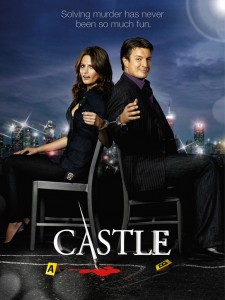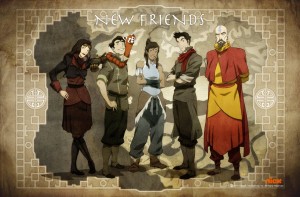Monday is usually everyone’s least favorite day of the week, but it isn’t for me thanks to a wonderful cop procedural dramedy known as Castle. It hit the airwaves in 2009 and has been kicking ass ever since with the help of geek god Nathan Fillion and the delicious Stana Katic.
Honestly, I wouldn’t be the same person I am now without this show—both as a writer and as a fangirl. In honor of its sixth season premiere, I’d like to share what this wonderful show has taught me over the years.
Unresolved sexual tension exists for a reason. Sexual tension. It’s a tale as old as time. Song as old as rhyme…wait, no, sorry, wrong story. The titular Castle and his muse, Detective Kate Beckett, wasted no time in sharing steamy chemistry by introducing it literally in the first episode. The first words out of his mouth upon meeting her (at a book release party where dozens of women gathered to drool over him) was, “Where would you like it?” while holding up a Sharpie to presumably sign her chest. Ever since then, it’s been a tango between the two. Castle fancied her from the second he laid eyes on her while Beckett remained unamused and uninterested for most of the first season, but she eventually warmed up to him. One of the most admirable things this show has done is taking the stigma out of the “Will They or Won’t They” trope, which is commonplace in all types of fiction. Castle was able to successfully introduce, explore, and resolve the sexual tension between the characters because the creator, Andrew W. Marlowe, and the cast actively disagree with the “Moonlighting Curse.” For any of you whippersnappers out there, Moonlighting was a 1980’s TV show with starring Bruce Willis and Cybill Shepherd as a dynamic duo of sorts who solved cases and had massive amounts of lust between them. However, after the two finally hooked up, the show immediately lost the audience’s interest and got canceled.
The relationship between Castle and Beckett worked because it developed naturally instead of being corralled by the writers. Their actions stayed true to the characters. They constantly made each other better and strengthened their bond before they took a tumble into the bedroom. Many writers struggle with this concept by making several rookie mistakes: resolving the tension too quickly (ex. Indiana Jones and Marion Ravenwood), dragging the tension along for too long (ex. Ross and Rachel), creating a pointless love triangle where one love interest is clearly the winner and the other gets strung along (Katniss Everdeen and Gale), etc. We’ve all seen this happen in shows/movies/anime/books we love. Castle taught me to fight the urge to force characters together too late or too soon. Allow each character to grow first and then worry about when and how they’ll connect. That will keep things steamy as well as preventing the reader from losing interest or becoming frustrated with the couple.
Supporting characters are the cream in the coffee. If for some bizarre reason you don’t fall in love with Castle and Beckett at first sight, the show has a fantastic spread of supporting protagonists to keep you happy. It is also one of the few shows that found a way to balance these people in Castle and Beckett’s lives, as in no one character steals the spotlight all the time.
More importantly, the secondary characters often provide the subplots that can help enhance the enjoyment of the main storyline. It has become a joke in the fandom that Castle’s daughter Alexis and his mother Martha have helped him solve as many murders as Beckett has due to their troublesome personal lives. It can be difficult building one’s own “cast” in a novel or short story, but it’s ultimately worth it because of diversity. Having more than just one or two characters allows comparisons to be drawn among them. It can highlight implicit and explicit conflict. It can give the character someone to antagonize or sympathize with. Supporting characters are just what their namesake says: they help hold the weight of the story and distribute it evenly.
Themes can be important and juicy tidbits to add to the story. There are a lot of themes in Castle—from overarching concepts like justice vs. revenge or lust vs. love, all the way down to the coffee that the two constantly share and their repeated phrase “Always” in favor of saying, “I love you” before the two became a couple. It has been one of the most enjoyable things about the series over the years. The writers of Castle know their stuff. They are careful to weave the threads throughout the series and create delightful parallels to entice the viewers and make them feel even more connected with the characters.
For example, (spoiler alert!) there’s the line that convinced Castle to begin shadowing Beckett for “research purposes” was after he offered to take her out on a date (and debrief her, ha-ha) and he tells her that it was too bad because it would have been great. The normally no-nonsense Beckett then bites her lip and whispers in his ear, “You have no idea.” Guess what happens the morning after the pair finally sleep together? Castle says, “You were right. I had no idea.” And that’s a distance of five seasons from the pilot to the season five opener. Keeping themes, lines, gags, and ideas like that is what makes the show so much fun to watch. Giving the fiction a definite continuity can further involve your readers and make them a part of what they’re seeing. Furthermore, they can end up hungering for more, like how us Marvel fans eagerly watch the Marvel Universe movies to see small shout outs to other heroes, and the always delightful cameo of Stan “The Man” Lee. Themes, when done properly, are just one more thing to love about a good book.
Keep an eye on your fans. This concept is dangerous, but also well worth the trouble if it works out just right. The Castle writers, creators, and actors are all connected to their audience through social media. Stana Katic and Nathan Fillion both live tweeted the season six premiere, and have done it more than once. They answer questions, post Behind-the-Scenes pics, and generally goof off just like their fans do. They make us feel welcome and tease us with all kinds of interesting things that the show is involved in.
As a writer, it’s important to stay connected to the readers for several reasons: (1) to gauge the general reception of your work (2) to find new readers (3) to catch flaws, criticism, or accidental plotholes that their eyes were good enough to catch (4) to discover new avenues that your work can travel that you may not have considered. For instance, the portmanteau couple name for Castle and Beckett in the fandom is “Caskett” (adorable, right?) and the show’s creators were so tickled by it that they snuck it into a season five episode. This caused a huge uproar of pure glee from the fandom to know that we had influenced our own show. It is a bit harder to integrate something like that into fiction, but it can result in further engrossing the readers when they know that they have your attention. They may even spread your fanbase by telling their friends what they helped create on their favorite show.
Castle’s sixth season has a lot left to show me and I can’t thank the writers/actors enough for giving us such an incredible run over the years. If you’re curious, tune in Monday nights at 10pm EST on ABC to see more of the lovable mystery novelist and his sexy detective. Maybe you’ll learn a little something too.
Kyoko


